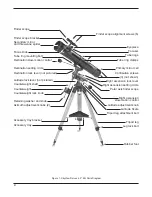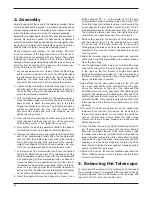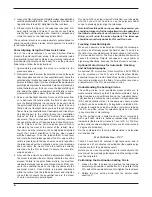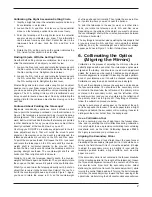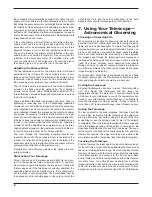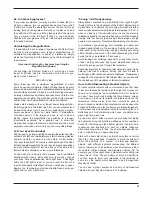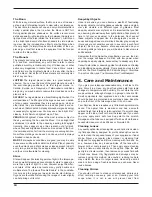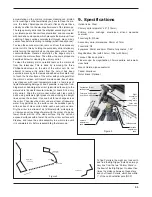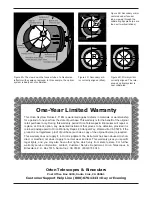
5
1. Keeping one hand on the telescope optical tube, loosen
the R.A. lock lever. Make sure the Dec. lock lever is
locked, for now. The telescope should now be able to
rotate freely about the R.A. axis. Rotate it until the coun-
terweight shaft is parallel to the ground (i.e., horizontal).
2. Now loosen the counterweight lock knob and slide the weight
along the shaft until it exactly counterbalances the telescope.
That’s the point at which the shaft remains horizontal even
when you let go of the telescope with both hands.
3. Retighten the counterweight lock knob. The telescope is
now balanced on the R.A. axis.
4. To balance the telescope on the Dec. axis, first tighten the
R.A. lock lever, with the counterweight shaft still in the hor-
izontal position.
5. With one hand on the telescope optical tube, loosen the
Dec. lock lever. The telescope should now be able to
rotate freely about the Dec. axis. Loosen the tube ring
clamps a few turns, until you can slide the telescope tube
forward and back inside the rings (this can be aided by
using a slight twisting motion on the optical tube while you
push or pull on it).
6. Position the telescope so that it remains horizontal when
you carefully let go with both hands. This is the balance
point. Before clamping the rings tight again, rotate the tele-
scope so the eyepiece is at a convenient angle for viewing.
When you are actually observing with the telescope, you
can adjust the eyepiece position by loosening the tube rings
and rotating the optical tube.
7. Retighten the tube ring clamps.
The telescope is now balanced on both axes. Now when you
loosen the lock lever on one or both axes and manually point
the telescope, it should move without resistance and should
not drift from where you point it.
4. Aligning the Finder Scope
A finder scope has a wide field of view to facilitate the loca-
tion of objects for subsequent viewing through the main
telescope, which has a much narrower field of view. The find-
er scope and the main telescope must be aligned so that they
point to exactly the same spot in the sky.
Alignment is easiest to do in daylight hours. First, insert the low-
est-power (25mm) eyepiece into the main telescope’s focuser.
Then loosen the R.A. and Dec. lock levers so the telescope can
be moved freely.
Point the telescope at a discrete object such as the top of a
telephone pole or a street sign that is at least a quarter-mile
away. Move the telescope so the target object appears in the
very center of the field of view when you look into the eye-
piece. Now tighten the R.A. and Dec. lock levers. Use the
slow-motion control knobs to re-center the object in the field of
view, if it moved off center when you tightened the lock levers.
Now look through the finder scope. Is the object centered in
the finder scope’s field of view, i.e., on the crosshairs? If not,
hopefully it will be visible somewhere in the field of view, so
that only fine adjustment of the alignment screws will be need-
ed. Otherwise you’ll have to make coarser adjustments to the
alignment screws to redirect the aim of the finder scope.
Use the six alignment screws to center the object on the
crosshairs of the finder scope. Then look again into the main
telescope’s eyepiece and see if it is still centered there as
well. If it isn’t, repeat the entire process, making sure not to
move the main telescope while adjusting the alignment of the
finder scope.
Note that the image seen through the finder scope
appears upside down. This is normal for astronomical
finder scopes.
5. Setting up and Using the
Equatorial Mount
When you look at the night sky, you no doubt have noticed that
the stars appear to move slowly from east to west over time.
That apparent motion is caused by the Earth’s rotation (from
west to east). An equatorial mount (Figure 2) is designed to
compensate for that motion, allowing you to easily “track” the
movement of astronomical objects, thereby keeping them
from drifting out of the telescope’s field of view while you’re
observing.
This is accomplished by slowly rotating the telescope on its right
ascension (polar) axis, using only the R.A. slow-motion cable. But
first, the R.A. axis of the mount must be aligned with the Earth’s
rotational (polar) axis — a process called polar alignment.
Polar Alignment
For Northern Hemisphere observers, approximate polar
alignment is achieved by pointing the mount’s R.A. axis at the
North Star, or Polaris. It lies within 1° of the north celestial
pole (NCP), which is an extension of the Earth’s rotational
axis out into space. Stars in the Northern Hemisphere appear
to revolve around Polaris.
To find Polaris in the sky, look north and locate the pattern of
the Big Dipper (Figure 3). The two stars at the end of the
“bowl” of the Big Dipper point right to Polaris.
Observers in the Southern Hemisphere aren’t so fortunate to
have a bright star so near the south celestial pole (SCP). The
star Sigma Octantis lies about 1° from the SCP, but it is bare-
ly visible with the naked eye (magnitude 5.5).
For general visual observation, an approximate polar align-
ment is sufficient.
1. Level the equatorial mount by adjusting the length of the
three tripod legs.
2. Loosen the latitude lock lever. Turn the latitude adjustment
knob and tilt the mount until the pointer on the latitude scale
is set at the latitude of your observing site. If you don’t know
your latitude, consult a geographical atlas to find it. For
example, if your latitude is 35° North, set the pointer to +35.
Then retighten the latitude lock lever. The latitude setting
should not have to be adjusted again unless you move to a
different viewing location some distance away.


